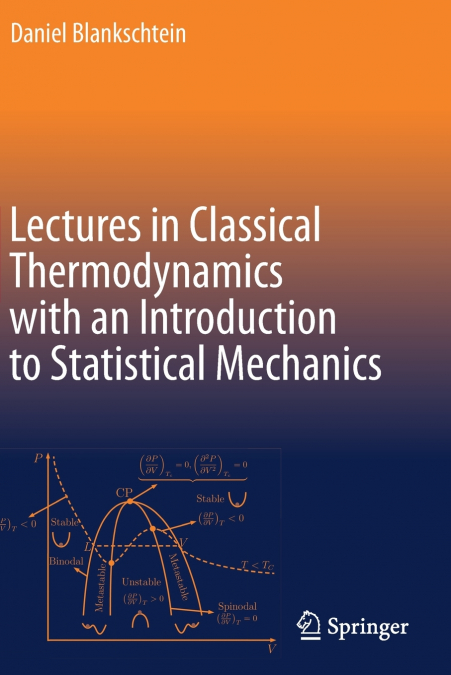
Daniel Blankschtein
Lecture 1:Book Overview.- Lecture 2:Basic Concepts and Definitions.- Lecture 3:First Law - Closed Systems: Derivation.- Lecture 4:First Law - Closed Systems: Derivation, Solution to Sample Problem 1.- Lecture 5:First Law - Closed Systems: Solution to Sample Problem 1, Continued.- Lecture 6:First Law - Open Systems: Derivation, Solution to Sample Problem 2.- Lecture 7:Second-Law Concepts.- Lecture 8:Heat Engine, Carnot Efficiency.- Lecture 9:Entropy, Reversibility.- Lecture 10:The Second Law of Thermodynamics, Maximum Work.- Lecture 11:The Combined First and Second Laws of Thermodynamics, Availability.- Lecture 12:Flow Work, Solution to Sample Problem 3.- Lecture 13:Fundamental Equations.- Lecture 14:Manipulation of Partial Derivatives.- Lecture 15:Gibbs Free Energy Formulation.- Lecture 16:Evaluation of Thermodynamic Data.- Lecture 17:Equation of State (EOS), Binodal, Spinodal, Critical Point.- Lecture 18:Principle of Corresponding States.- Lecture 19:Departure Functions.- Lecture 20:Review for Part I.- .- Lecture 21:Extensive and Intensive Mixture Properties, Partial Molar Properties.- Lecture 22:Generalized Gibbs-Duhem Relations for Mixtures, Calculation of Partial Molar Properties.- Lecture 23:Mixture EOS, Mixture Departure Functions, Ideal-Gas Mixtures, Ideal Solutions.- Lecture 24:Mixing Functions, Excess Functions.- Lecture 25:Fugacity, Fugacity Coefficient.- Lecture 26:Activity, Activity Coefficient.- Lecture 27:Criteria of Phase Equilibria, Gibbs Phase Rule.- Lecture 28:Applications of the Gibbs Phase Rule, Azeotrope.- Lecture 29:Differential Approach to Phase Equilibria, Pressure-Temperature-Composition Relations, Clausius-Clapeyron Equation.- Lecture 30:Integral Approach to Phase Equilibria, Composition Models.- Lecture 31:Chemical Equilibria: Stoichiometric Formulation.- Lecture 32:Equilibrium Constants for Gas-Phase and Condensed-Phase Reactions.- Lecture 33:Response of Chemical Reactions to Temperature, Le Chatelier’s Principle.- Lecture 34:Response of Chemical Reactions to Pressure, Applications.- Lecture 35:Gibbs Phase Rule for Chemically- Reacting Systems, Applications.- Lecture 36:Effect of Chemical Equilibrium on Thermodynamic Properties.- Lecture 37:Review for Part II.- Lecture 38:Quantum Statistical Mechanics, Canonical Ensemble, Probability and the Boltzmann Factor, Canonical Partition Function.- Lecture 39:Calculation of Thermodynamic Properties from the Canonical Partition Function, Treatment of Distinguishable and Indistinguishable Molecules.- Lecture 40:Translational, Vibrational, Rotational, and Electronic Partition Functions of Ideal Gases.- Lecture 41:Calculation of Thermodynamic Properties of Ideal Gases from the Partition Functions.- Lecture 42:Microcanonical Ensemble, Statistical Mechanical Definition and Interpretation of Entropy and Work.- Lecture 43:Statistical Mechanical Interpretation of the First, Second, and Third Laws of Thermodynamics.- .- Lecture 44:Grand Canonical Ensemble, Statistical Fluctuations.- Lecture 45:Classical Statistical Mechanics.- Lecture 46:Configurational Integral, Statistical Mechanical Derivation of the Virial Equation of State.- Lecture 47:Virial Coefficients in the Classical Limit, Statistical Mechanical Derivation of the van der Waals Equation of State.- Lecture 48:Statistical Mechanical Treatment of Chemical Equilibrium.- Lecture 49:Statistical Mechanical Treatment of Binary Mixtures.- Lecture 50:Review for Part III and Book Overview.